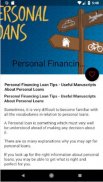















Personal Loans For Bad Credit - How To Get A Loan

Descrizione di Personal Loans For Bad Credit - How To Get A Loan
Whether because of poor financial decisions or plain bad luck, you might find yourself with a low credit score and the need to take out a loan. It’s a Catch-22 combo that can leave you wondering, “How can I get a loan with bad credit?”
Your credit score can define you in the eyes of a lender.
That mysterious, magical number on your credit report is the single most important factor for securing a loan. Bad credit is, well, bad. But not having credit at all is also a major strike against you.
Interested in getting a loan for bad credit? This guide is for you.
But let’s get the basics out of the way first: “bad credit” and “no credit” are quite different.
A credit score is a number between 0 and 999. It is essentially a rating by which your credit risk profile is determined.
A score closer to zero means someone is more likely to default on credit and is seen as a higher risk. A score closer to 999 is seen as positive and more trustworthy. This means someone is less likely to default on a debt.
A credit score is taken at a specific point in time. It does not account for your future potential. It is only a summary of your credit history.
Your credit history is, therefore, displayed as a score for lenders to use to determine if they want to offer you a loan.
Having a bad credit score means you have a poor credit history. Essentially, at some point, you took on credit you couldn’t pay back.
Having no credit score means you have no credit experience. Lenders have no way of knowing whether they can trust you to pay back your loan.
Both can prevent you from getting a loan; however, having a bad credit score is worse than having no credit score. Having a bad credit score means you have a bad track record and a potential lender will see this as a red flag — you can even be denied a job because of it! Having no credit experience is also a red flag, but a lesser one; while there is nothing to hold against you, there is also nothing going in your favor.
Young people, recent immigrants, and people who have typically accrued expenses under others’ names (family or siblings) tend to have this problem. Or, some combination of all 3 personas (e.g. young immigrants).
Lenders just can’t tell whether you are going to be good with credit. Having a bad history or no experience with credit can work against you, but neither is insurmountable. It’s important to understand the difference between the two and how they are used to profile you financially so that you can strategize ways to overcome them.
So what qualifies as bad credit?
The answer will differ from lender to lender. Different lenders will regard different credit scores as “unacceptable”. Generally, however, a credit score below 629 is considered “bad”.
Download Personal Loans for Bad Credit now for get more info.
This application features are :-
You can bookmark Favorite articles(post)
This application helps you to read the article(post) - Once click 'Read Article' button, automatically read the page content(Text to Speech).
You can share the article(post) to your friends, family and social networks.
You can copy the text from any post.
You can enable notification
You can adjust font size(small, medium, big) of articles
Sia a causa di scarse decisioni finanziarie o di semplice sfortuna, potresti ritrovarti con un basso punteggio di credito e la necessità di contrarre un prestito. È un combo di Catch-22 che può lasciarti a bocca aperta, "Come posso ottenere un prestito con cattivo credito?"
Il tuo punteggio di credito può definirti agli occhi di un creditore.
Quel numero misterioso e magico sul tuo rapporto di credito è il singolo fattore più importante per ottenere un prestito. Il cattivo credito è, beh, cattivo. Ma non avere alcun credito è anche uno sciopero importante contro di te.
Interessato ad ottenere un prestito per cattivo credito? Questa guida è per te.
Ma prima prendiamo le basi: "cattivo credito" e "niente credito" sono molto diversi.
Un punteggio di credito è un numero compreso tra 0 e 999. Si tratta essenzialmente di un rating in base al quale viene determinato il profilo di rischio di credito.
Un punteggio più vicino allo zero significa che qualcuno è più propenso ad andare in default a credito ed è visto come un rischio più elevato. Un punteggio più vicino a 999 è considerato positivo e più affidabile. Ciò significa che è meno probabile che qualcuno stia per inadempimento su un debito.
Un punteggio di credito viene preso in un momento specifico. Non tiene conto del tuo potenziale futuro. È solo un riassunto della tua storia di credito.
La tua storia di credito è, quindi, visualizzata come un punteggio per i creditori da utilizzare per determinare se vogliono offrirti un prestito.
Avere un punteggio di credito cattivo significa che hai una storia creditizia scadente. In sostanza, ad un certo punto, ti sei assunto un credito che non potevi rimborsare.
Non avere un punteggio di credito significa che non hai esperienza di credito. I creditori non hanno modo di sapere se possono fidarsi di te per rimborsare il tuo prestito.
Entrambi possono impedirti di ottenere un prestito; tuttavia, avere un punteggio di credito cattivo è peggio che non avere un punteggio di credito. Avere un brutto punteggio di credito significa che hai una cattiva esperienza e che un potenziale prestatore vedrà questo come una bandiera rossa - si può anche essere negato un lavoro a causa di esso! Non avere esperienza di credito è anche una bandiera rossa, ma una minore; mentre non c'è nulla da tenere contro di te, non c'è nulla che possa andare a tuo favore.
I giovani, gli immigrati recenti e le persone che in genere hanno accumulato spese sotto il nome di altri (famiglia o fratelli) tendono ad avere questo problema. Oppure, una combinazione di tutti e 3 i personaggi (ad es. Giovani immigrati).
Istituti di credito non riescono a capire se starai bene con il credito. Avere una brutta storia o nessuna esperienza con il credito può funzionare contro di te, ma nessuno dei due è insormontabile. È importante capire la differenza tra i due e il modo in cui vengono utilizzati per delineare il profilo finanziario in modo da poter individuare strategie per superarli.
Quindi cosa si qualifica come cattivo credito?
La risposta sarà diversa dal prestatore al creditore. Diversi istituti di credito considereranno i diversi punteggi di credito "inaccettabili". In generale, tuttavia, un punteggio di credito inferiore a 629 è considerato "cattivo".
Scarica Prestiti personali per Bad Credit ora per ottenere maggiori informazioni.
Queste caratteristiche dell'applicazione sono: -
È possibile aggiungere un segnalibro agli articoli preferiti (post)
Questa applicazione ti aiuta a leggere l'articolo (post) - Una volta fatto clic sul pulsante 'Leggi articolo', legge automaticamente il contenuto della pagina (sintesi vocale).
Puoi condividere l'articolo (post) con i tuoi amici, familiari e social network.
Puoi copiare il testo da qualsiasi post.
È possibile abilitare la notifica
È possibile regolare la dimensione del carattere (piccolo, medio, grande) di articoli

























